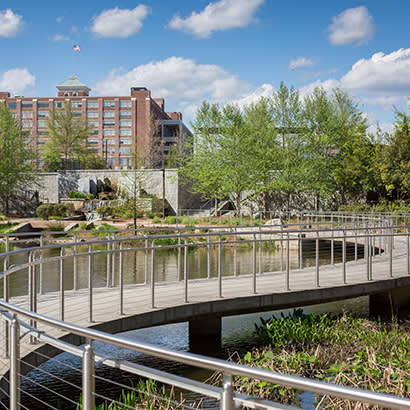
For an enhanced digital experience, read this story in the ezine.
Infrastructure is a word that has been tossed around a lot in recent years. Policymakers have talked about the need for not only shoring up the nation’s deteriorating infrastructure, but also building more to support a growing, more diverse population. More recently, investing in infrastructure has gained renewed interest in the context of the economic recovery coming out of the coronavirus (COVID-19) pandemic. But, at times, parks and recreation has not had a seat at the table for these conversations.
The pandemic demonstrated to many people what we already knew: parks and recreation is essential infrastructure. Local park and recreation agencies across the United States maintain millions of acres of parkland, sprawling trail networks and other public open spaces that promote better physical and mental health, serve as a meeting place that brings family, friends and fellow neighbors together, and contribute as an integral part of community environmental and disaster response. Park and recreation infrastructure itself is diverse and includes recreation centers, community centers, nature centers, pools, sports fields and courts, bridges, outdoor lighting, electrical and water utilities, and many other assets.
Park and recreation infrastructure is as critical to the vitality of cities, towns and counties as are the assets managed by any other government agency and department, including those of public works, utilities, transportation and education. But at the same time, park and recreation infrastructure does not benefit from sustained funding support that many of these other entities receive.
The result of the funding disparity is aging assets that are falling in disrepair even as park and recreation usage rises to record levels. According to NRPA Park Metrics, NRPA’s benchmarking resource, park and recreation agencies have on average $17.4 million in deferred maintenance projects on their books. Considering the more than 10,000 local park and recreation agencies of varying sizes and missions, NRPA estimates that the total value of deferred park and recreation maintenance at agencies across the nation exceeds more than $60 billion.
The American Society of Civil Engineers gave a D+ rating to park and recreation infrastructure in its 2020 Report Card for America’s Infrastructure. The report notes a D grade, indicating “[t]he infrastructure is in poor to fair condition and mostly below standard, with many elements approaching the end of their service life. A large portion of the system exhibits significant deterioration. Condition and capacity are of serious concern with strong risk of failure.”
But it is not just about maintaining existing infrastructure. Parks and recreation must grow and evolve to continue serving communities. And, this means new construction. The U.S. Census Bureau estimates state and local governments spent more than $10 billion in 2020 on building parks, community centers and sports infrastructure. Remarkably, this matches 2019 spending levels after adjusting for inflation. Even better, it was up by more than 40 percent versus 2013 expenditures. But the bad news is that park and recreation infrastructure is struggling to keep up with the population it serves. Park and recreation construction spending in 2020 only matched spending in 2009, even though the nation’s population has risen nearly nine percent.
The underinvestment in park and recreation infrastructure is not due to a lack of desire by the public. More than nine in 10 respondents to the July 2021 NRPA Park Pulse Poll agree it is important for their local government to invest in community infrastructure, including parks, community and senior centers, and recreation facilities. In a time of seemingly great political divisiveness, the nation is united in its support to fully fund park and recreation infrastructure, with no difference seen by the gender, age, race, ethnicity, income, education and household formation of respondents.
The ubiquity of support is a part of the solution to fund park and recreation infrastructure. The general public agrees that your work is essential. Next month we will review the findings from the 2021 Engagement With Parks Report that further make the case for greater and more sustainable funding for the work you and your fellow park and recreation professionals deliver every day.
Kevin Roth is NRPA’s Vice President of Research, Evaluation and Technology.


